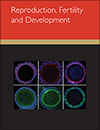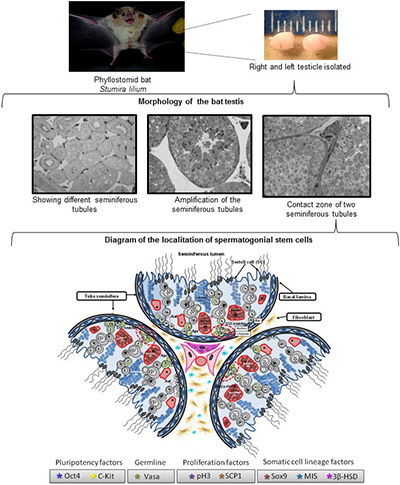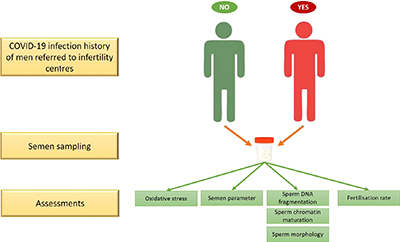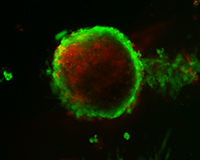A population of sperm progenitor cells, known as Asingle spermatogonia, has been described in mammalian testes, but these cells have not been studied in bat testes. Bats are a good model due to their human-like reproductive characteristics. The results show the existence of spermatogonial stem cells that constantly renew spermatogenesis in these chiropterans, similar to that described in other mammals such as humans. Image by Tania Porras-Gómez and Norma Moreno-Mendoza.

Reproduction, Fertility and Development
Volume 36 Number 11 2024
There is mounting evidence implicating kisspeptin signalling in placental development and function. We sought to elucidate kisspeptin’s role in the placenta using three experimental models: a mouse kisspeptin receptor knockout model, culture of human BeWo trophoblast cells, and a human placenta punch biopsy. Our results indicate that kisspeptin may inhibit trophoblast invasion, although further investigation is required to clarify specific regulatory mechanisms. Image by https://www.clker.com/clipart-white-mouse-1.html and adapted from M. Arvola and R. Mattsson (https://doi.org/10.1038/npg.els.0001438).
RD23230 Abstract | RD23230 Full Text | RD23230PDF (1.2 MB) | RD23230Supplementary Material (1.1 MB) Open Access Article
In recent years, the COVID-19 pandemic has been considered a threat to human health. The SARS-CoV-2 virus has caused various disorders in the body’s systems and the reproductive system is no exception. Based on the result of present study, COVID-19 infection increases the oxidative stress and reduces the semen quality, thus reducing the fertility potential. Illustration by Sareh Karimi.
Testicular organoids (TOs) represent a groundbreaking avenue captivating researchers seeking to understand and restore fertility. While TOs hold remarkable potential, their journey to replicate human spermatogenesis within a laboratory environment remains elusive. This review navigates the landscape of TOs, unveiling their unparalleled potential while dissecting the challenges hindering their success, helping refine these models for transformative clinical applications. Photograph by K. Coward..
This article belongs to the Collection Dedication to Jim Cummins.








